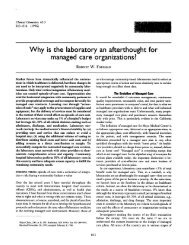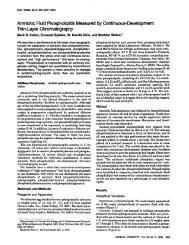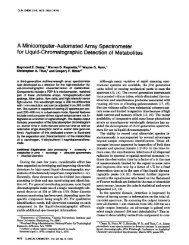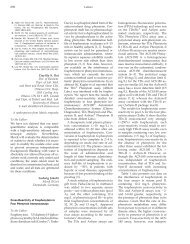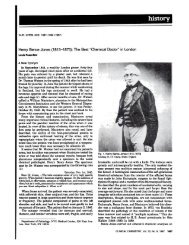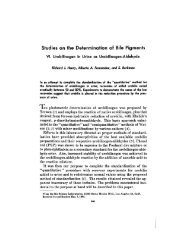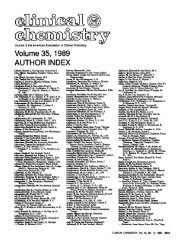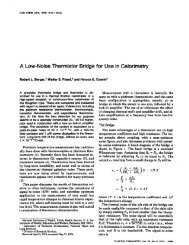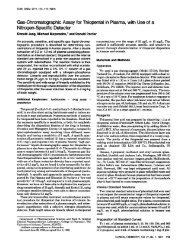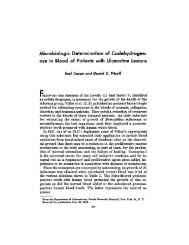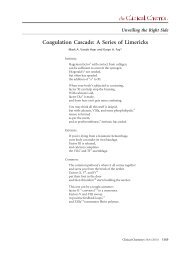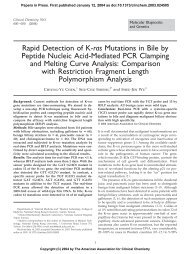Analytical Bias in a Quality Control Scheme - Clinical Chemistry
Analytical Bias in a Quality Control Scheme - Clinical Chemistry
Analytical Bias in a Quality Control Scheme - Clinical Chemistry
You also want an ePaper? Increase the reach of your titles
YUMPU automatically turns print PDFs into web optimized ePapers that Google loves.
Vol. 15, No. II. 1969 ANALYTICAL BIAS 1041<br />
Table 1. ItEsuhis wirti BLIND (\ERsroI.) ANn KNOWN (Pool.) C sraoi.s .r<br />
Onio STATE UNIVERSITY HOSPITALS, 0’T. 1967-MARcH 1968<br />
Specimen .Wean<br />
Versatol<br />
SI) CV .Vo. Mean<br />
Pool<br />
SD CV No.<br />
Album<strong>in</strong> 3.4 0.16 2.9 127 4.3 0.13 3.0 133<br />
Calcium 4.8 0.10 40 127 4.2 0.09 2.2 164<br />
Chb)ridet 102 1 .6 1 .6 127 104 0.8 0.8 182<br />
Creatituiuuet 1.7 0.11 6.3 123 1.9 0.08 4.4 183<br />
(iIobiJ<strong>in</strong> 2.2 0.12 5.7 129 2.6 0.13 5.6 137<br />
(;lucoset 82 :1.4 4.2 126 116 2.7 2.3 183<br />
r.P. 4.3 0.30 6.7 125 4.0 0.21) 4.9 126<br />
Kt 3.0 0.13 3.0 126 4.7 0.12 2.5 183<br />
Nat 140 2.4 1.7 127 143 1.2 0.8 l83<br />
Tot, prote<strong>in</strong> 7.6 0.19 2.5 12$ 73) 0.17 2.4 136<br />
Urea-Nt 12.5 0.8 6.6 125 25.2 0.8 3.0 183<br />
Uric Acidt 3.9 0.27 4.5 173 5.6 0.22 4.0 182<br />
Cholesterol 224 13 6.5 127 200 7.0 :1.3 124<br />
Alk. p’tase 6.9 0.4:1 6.2 126 2.6 0.15 3.6 127<br />
Amylase 230 17 6.9 127 103 10 9.7 173<br />
LDH 303 52 10.4 12(1 261 24 9.3 131<br />
SOOT 133 12 9.3 121 23.7 3.2 13 129<br />
SGPT 10.7 3.0 28 111 18.9 3.1 16 121<br />
* Ntunber of analyses for each constituent is equal to the number of days on which the given<br />
procedure ha.s beemi reported.<br />
f Automated procedures.<br />
Exam<strong>in</strong>ation of each of the seven automated tests shows that the<br />
average of the monthly standard deviations and of the monthly coefficients<br />
of variation of the unknown control samples was greater<br />
than the known samples <strong>in</strong> all cases (7+). The probability of this<br />
occurr<strong>in</strong>g by chance is less than 0.01.<br />
Of the 11 nonautomated tests, tile standard deviation of tile unknown<br />
controls was greater than that of known controls <strong>in</strong> 9 <strong>in</strong>stances, and<br />
tue coefficient of variation was greater <strong>in</strong> eight tests. The probability<br />
of this occurr<strong>in</strong>g by chance is 0.027 for the standard deviation arid<br />
0.081 for the coefficient of variation.<br />
Discussion<br />
The data <strong>in</strong> Table 1 illustrate tile variation between “known” controls<br />
and ‘‘bl<strong>in</strong>d’’ controls <strong>in</strong> several rout<strong>in</strong>e cl<strong>in</strong>ical chemistry tests.<br />
The “bl<strong>in</strong>d” sample, more like that of a patient’s specimen, measures<br />
Ilie precision actually achieved Ill the laboratory, <strong>in</strong> contrast to<br />
“known’’ controls which measure tile precision the laboratory is<br />
capable of achiev<strong>in</strong>g. It should 1)e emphasized that these data were<br />
collected by do<strong>in</strong>g just one set of control samples a day, and except<br />
for the known control samples chosen by the technologist for check<strong>in</strong>g




